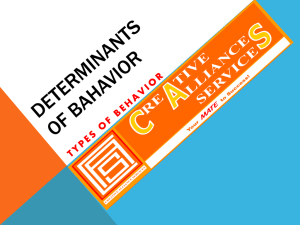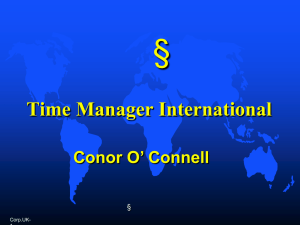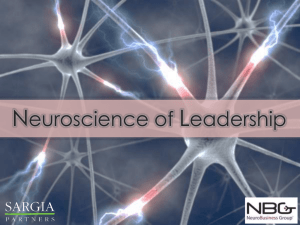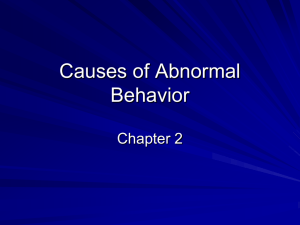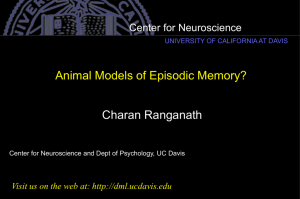Document 12731726
advertisement
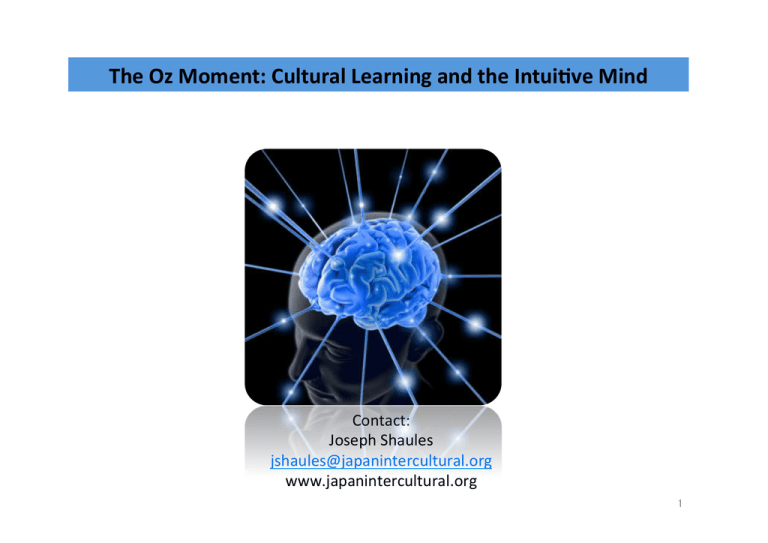
The Oz Moment: Cultural Learning and the Intui7ve Mind Contact: Joseph Shaules jshaules@japanintercultural.org www.japanintercultural.org 1 1959 “The important part of culture exists safely hidden below the level of conscious awareness.” Edward T. Hall (Beyond Culture) 2 Cultural and social neuroscience Cultural neuroscience . . . seeks to explain how neurobiological processes such as geneKc expression and brain funcKon, give rise to cultural values, pracKces, and beliefs as well as how culture shapes neurobiological processes across macro-­‐ and micro-­‐Kme scales. Joan Chiao Social neuroscience is the product of the integraKon of neuroscience (parKcularly neuroimaging), cogniKve science and social sciences (parKcularly social psychology), and it allows one to invesKgate the complex and dynamic representaKon of social interacKon in the brain’s neural states. The field aims to uncover the neural underpinnings of social processes, such as mental aPribuKon, empathy and moral judgment. Han & Northoff 3 Cognitive neuroscience is providing us with a new view of the relationship between culture and mind . . . Three brains, two minds, one person, The brain was shaped by millions of years of evoluKonary biology. It has a triune (three-­‐part) structure related to different stages of evoluKon. Enfolded in the human brain are the rep7lian, mammalian and primate (neo-­‐cortex) brains. Mind refers to mental experience made possible by cogniKve funcKon. It includes wakefulness, aPenKon, feeling, intuiKon, consciousness and conscious thought. Cultural paPerns are configured into the cogniKve processes that produce mind. i.e. Our mind is shaped by culture. The mind was also shaped by evoluKonary biology. It evolved an ability to carry out rouKne tasks (even complex ones) without conscious awareness (intui7ve mind). Conscious thought evolved to cope with novel situaKons and solve problems through the manipulaKon of mental images (a:en7ve mind). Culture and our three brains We are animals that think. We have basic insKncts and drives, (we experience hunger – repKle brain), learn complex tasks to saKsfy them (bake cookies – neo-­‐cortex), are driven by emoKon (get upset if they burn – limbic system), and think abstractly and morally about what we do (decide to eat salad the next day – neo-­‐cortex). Culture and our three brains Cultural paPerns are integrated into all areas of brain funcKon. That is why our heart races when we hear “I love you” or if we see our flag burned, why we can get excited by an idea, or angry if someone steals our money, even though “love” “flag” “idea” and “money” are primarily mental phenomena. Two minds Unconscious cognition Mental processes that are inaccessible to consciousness but that influence judgments, feelings or behavior. Timothy Wilson The mind operates most efficiently by relegating a good deal of high-level, sophisticated thinking to the unconscious, just as a modern jumbo jetliner is able to fly on automatic pilot with little or no input from the human “conscious” pilot. Timothy Wilson The adap$ve unconscious is part of the architecture of the mind that is inaccessible to conscious awareness. People can no more observe how they are unconsciously categorizing their environments, se9ng goals, and genera<ng intui<ons than they can observe how their kidneys work. Timothy Wilson Deep Culture Configura7on Deep Culture Configura7on Shared meaning, scripts and schema needed to interact successfully within a community. Behavior ReflecKve mind IntuiKve mind Explicit mind Implicit knowledge Perceptual systems Learning Language processing Unconscious support systems The “dual processing” model of mind Adapted from Evans, 2010 Édouard Claparède PaKent later refuses handshake despite no conscious memory Claparède pricks amnesia paKent when shaking hands Pa:ern recogni7on . . . Which is the Sicilian defense Najdorf variaKon? Intercultural experiences affect us at two levels of self – conscious and uncoscious When I go to Canada, I‘ll practice English! Kentaro goes to Canada . . . Canada WOW! English everywhere! Japan The Oz Moment I’ve a feeling we’re not in Kansas anymore, Toto! Oz Moment “I’ve a feeling I’m not in California anymore!” Monitor your minds A:en7ve mind Wow! Lots of vending machines! Why so many? People must be busy! Not eco! Honest country! Intui7ve mind NoKce them! Interpret them! Judge them! A:en7ve mind Our two minds internal dialogue problem solving conscious planning abstract thinking focused aPenKon Intui7ve mind paPern detector implicit learner informaKon filter feeling evaluator goal sefng habitual processes Anatomy of an Oz moment . . . Enter foreign environment Mismatch with internal models! Decision making Suppress reaction? Take action? Intuitive scanning and filtering Make sense of situation Detect Difference Affective response Alert attentive mind Activate interpretive schema intuitive interpretation attentive analysis Intuitive response Pos/neg associations? Detect new patterns? Judge and resist? Adapt and change? Attentive response Analyze? Reflect? Cognitive impacts Long-term effects? Oz moment memories? New behaviors? Dissonance? Reinforced prejudice? Changed perspecKve? Culture and unconscious cogniKon Intercultural experiences can be surface (aPenKve mind) or deep (intuiKve mind) 20 Who is having an intercultural experience? Who is more internaKonal? Ludovic The hitchhiker 5 years hitchhiking around the world – 59 countries, 170,000 Km Bilingual – Fr & Eng Yuko The third-­‐culture kid Born Japan – Intl school India, University US, Return Japan at 22 Trilingual – Hindi, Jp, Eng Cultural Learning: Surface vs. Deep Surface learning: conscious knowing Tourist and traveler: explicit culture, explanaKons, outsider’s perspecKve e.g. tourist spots, historical knowledge, e<queCe Deep learning: unconscious reconfigura7on Sojourner: trial and error, cultural intuiKons, frame shiling, insider’s perspecKve e.g. changing percep<ons, value shiDs, iden<ty shiDs ConfiguraKon: Cultural difference The intuiKve mind is configured and shaped by cultural paPerns. 24 Which of the images goes together with the cow? NisbeP – The Geography of Thought NisbeP – The Geography of Thought Plato – subjectobject thinking Dialectic education Cognition impacts social interaction Western medicine Taoism – holistic thinking Chinese medicine Confucian education Individualism Collectivism Social structures and tendencies Category / object Sleep separately from children Context / relationship Cognitive preferences Sleep together with children Social pracKces Social interaction affects cognition Fractal culture: The feedback loop between cognition and social systems What do you see? 29 © 2008 Joseph Shaules Honor in the hallway . . . Asshole! Nisbe: and Cohen, 1996 Who decides? Iyengar: The Art of Choosing By comparing cogniKve funcKons in people from Western (European and American) and East Asian (Chinese, Japanese, Korean, et cetera) cultures, the 'culture-­‐and-­‐cogniKon' approach demonstrates that different sociocultural systems give rise to dissimilar thought styles. • Westerners generally think in an analy7cal way, whereas East Asians generally think in a more holis7c manner. For instance, during a percepKon task, Americans were bePer at detecKng changes in salient objects than East Asians, and were less affected by contextual informaKon. • Cultural differences are also evident in social cogni7on. In a game that involved two individuals interacKng, Chinese par7cipants were more in tune with their partner's perspec7ve than Americans. • Furthermore, Chinese people were more likely to describe memories of social and historical events and focused more on social interacKons, whereas European Americans more frequently focused on memories of personal experiences and emphasized their personal roles in events. • • Westerners were be:er at remembering trait words that they associated with themselves than they were at remembering words that they associated with people close to them, whereas Chinese people remembered both equally well. Americans tended to explain behaviours in terms of peoples' disposi7ons (for example, a person's gender and educaKon), whereas East Asians showed a preference for a:ribu7ng behaviour to situa7onal factors (for example, environmental events), and were more likely to use situaKonal informaKon to predict other people's behaviour. • Chinese people endorsed contextual explana7ons of physical events (for example, fricKon influencing the movement of an object) more olen than Americans, who were more likely to aPribute physical events to disposiKonal factors (for example, an object's weight or composiKon). • Culture also influences category-­‐based classifica7on of objects: Chinese people organized objects in a more relaKonal (for example, to group a monkey and a banana together because monkeys eat bananas) and less categorical (for example, to group a monkey and a panda together because both are animals) way than European Americans. Han and Northoff (2008) 32 Things to keep in mind . . . -­‐ The effects of culture on cogniKon are powerful invisible to us. That’s why foreign experiences are so eye-­‐opening. -­‐ GlobalizaKon has not eliminated cross-­‐cultural challenges. -­‐ Cultural adaptaKon involves learning to read intuiKve foreign cultural paPerns. Culture shock is a form of cogniKve overload. -­‐ Foreign experiences provide a chance to explore your unconscious mind. Oz moments are an indicaKon of unconscious cultural learning. 33 Reading Download an arKcle about culture and cogniKon: hPps://dl.dropboxusercontent.com/u/9302764/Intercultural%20Mind/SIETAR-­‐Europa-­‐Journal-­‐Shaules-­‐Culture-­‐CogniKon-­‐New-­‐Science-­‐of-­‐Mind.pdf Download today’s PowerPoint slides hPps://dl.dropboxusercontent.com/u/9302764/FIGT-­‐Seminar.ps Books • The Intercultural Mind, Shaules, Intercultural Press (in press –Fall 2014) • Deep Culture: The Hidden Barriers to International Living, Shaules, Multilingual Matters (2007) • The Beginner’s Guide to the Deep Culture Experience: Beneath the Surface, Shaules, Intercultural Press (2011) • Strangers to Ourselves: Discovering the Adaptive Unconscious, Timothy D. Wilson, Belknap Harvard, 2002 • The Geography of Thought: How Asians and Westerners Think Differently . . . And Why, Richard E. Nisbett, Free Press, 2004 • Thinking Fast and Slow, Daniel Kahneman, FSG, 2011 • Thinking Twice: Two minds in One Brain, Jonathan Evans, Oxford, 2010 34 The Oz Moment: Cultural Learning and the Intui7ve Mind Contact: Joseph Shaules jshaules@japanintercultural.org www.japanintercultural.org 35
